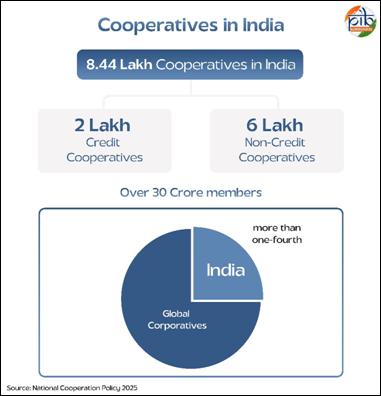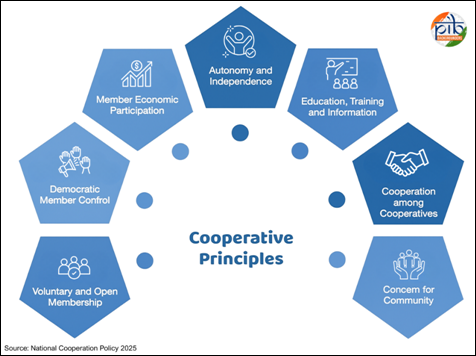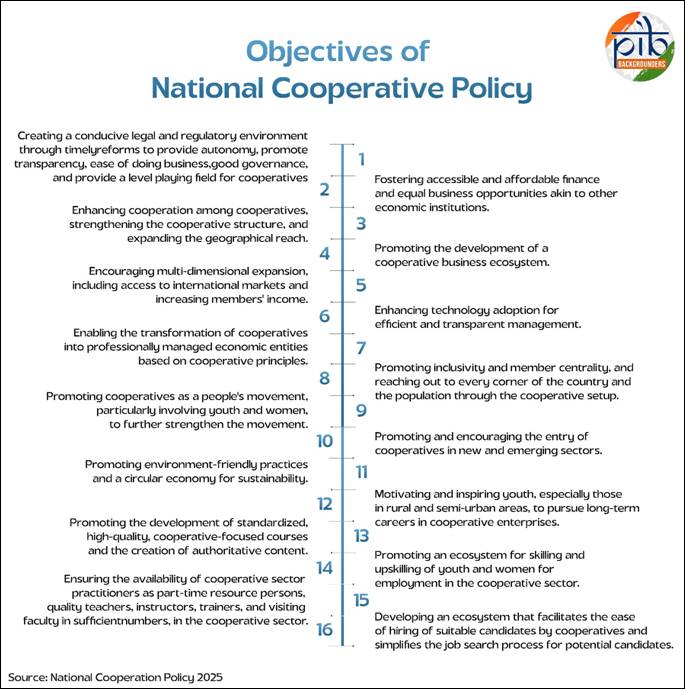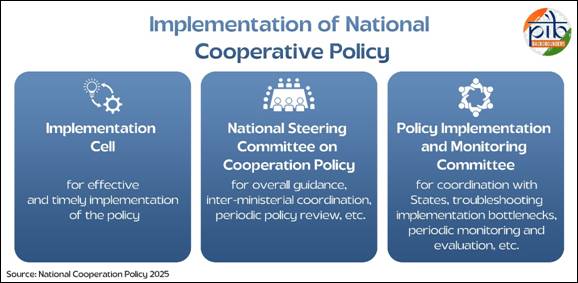Farmer's Welfare
National Cooperation Policy 2025
Posted On: 02 AUG 2025 10:47 AM
Cooperation to Prosperity: Paving the Way for Viksit Bharat 2047
Cooperation has been an integral part of India’s heritage. Even small things or limited resources, when united, can achieve significant results.
- Prime Minister Narendra Modi
Key Takeaways
- India has over 8.44 lakh cooperatives with 30+ crore members.
- The National Cooperation Policy aims to make cooperatives key drivers for Viksit Bharat 2047 through Sahkar-se-Samriddhi.
- Focus is on legal reforms, digitalization, and financial empowerment.
- The policy promotes inclusive participation of women, youth, SC/STs.
- The policy also suggests expansion of cooperatives into new sectors like clean energy, waste management, and technology.
Introduction
The National Cooperation Policy (NCP) 2025 marks a strategic roadmap for revitalizing India’s cooperative sector to meet the nation’s goal of becoming “Viksit” by 2047. Rooted in the ethos of Sahkar-se-Samriddhi, this policy aims to build on the unique strengths of India’s cooperative tradition, promote economic democratization, and uplift rural economies through collective participation.
- India is home to over 8.44 lakh cooperatives, including 2 lakh credit cooperatives and 6 lakh non-credit cooperatives spanning housing, dairy, fisheries, and more.
- With over 30 crore members, cooperatives remain a key socio-economic driver, especially in rural India.

India has more than one-fourth of the world's cooperatives.
What is a Cooperative?
A cooperative is an autonomous association of persons, united voluntarily to meet their common economic, social, and cultural needs and aspirations through a jointly owned and democratically member-controlled enterprise.
Difference between Credit and Non-Credit Cooperatives
|
Aspect
|
Credit Cooperatives
|
Non-Credit Cooperatives
|
|
Function
|
Provide financial services like loans and savings
|
Provide goods/services like farming inputs, housing, etc.
|
|
Examples
|
PACS, Urban Cooperative Banks
|
Dairy, Marketing, Consumer, Housing Cooperatives
|
The Indian cooperative movement has been the flag bearer of a participatory, people-led development model aimed at socio-economic upliftment at the grassroots level for more than a century. Cooperatives in India are guided by core cooperative principles and they are owned by members, operated by members, and for the benefit of members.

Historical Context & Need for a New Policy
The last cooperative policy, framed in 2002, was now proving to be outdated due to the radical shifts brought on by globalization, digitization, and socio-economic transformation.
Recognizing these developments, the Ministry of Cooperation (established in 2021) initiated the formulation of a new policy in September 2022.
A 48-member committee, led by Shri Suresh Prabhu, consulted stakeholders across 4 regional workshops and 17 meetings, collecting a total of 648 inputs to draft the current policy. The committee comprised members from national/state cooperative federations and societies across all levels and sectors, representatives from related Central and State Government Ministries/Departments, and academia.
Vision, Mission & Objectives
Vision
To significantly contribute to India’s collective ambition of becoming ‘Viksit' by 2047 through the promotion of an environment conducive to sustainable cooperative development, following the vision of 'Sahkar-se-Samriddhi'.
Mission
To create an enabling legal, economic, and institutional framework that will strengthen and deepen the cooperative movement at the grassroots level and facilitate the transformation of cooperative enterprises into professionally managed, transparent, technology-enabled, vibrant, and responsive economic entities to support production by the masses.

Strategic Pillars
The policy is structured around six mission pillars and 16 objectives:
- Strengthening the Foundation – Legal reforms, better governance, access to finance, digitalization.
- Promoting Vibrancy – Creating business ecosystems, expanding exports and rural clusters.
- Making Cooperatives Future-Ready – Technology integration, professional management, cooperative stack.
- Promoting Inclusivity and Deepening Reach – Promoting cooperative-led inclusive development and cooperatives as a people’s movement.
- Entering New and Emerging Sectors – Biogas, clean energy, warehousing, healthcare, etc.
- Shaping Young Generation for Cooperative Growth – Courses, training, employment exchanges.
Key Highlights of the Policy
Legislative and Institutional Reforms
- Encourage States to amend cooperative laws (Cooperative Societies Acts and Rules) to enhance transparency, autonomy and the ease of doing business.
- Promote digitalization of registrar offices and real-time cooperative databases.
- Revive sick cooperatives with institutional mechanisms.
Financial Empowerment
- Preserve and promote the three-tier Primary Agriculture Credit Societies - District Central Cooperative Bank - State Cooperative Bank credit structure.
- Promote cooperative banks and umbrella organizations (like National Urban Cooperative Finance & Development Corporation).
- Enable cooperative banks to handle government businesses.
Business Ecosystem Development
- Model cooperative villages with multipurpose PACS as growth engines.
- Encouraging States/UTs to develop at least one model cooperative village.
- Develop rural economic clusters (e.g., honey, spices, tea).
- Support branding under the ‘Bharat’ brand.
Model Cooperative Village
A Model Cooperative Village is a self-reliant rural unit developed through a cooperative-led, household-focused approach to enhance livelihoods and productivity.
Future-Readiness & Technology
- Develop a national ‘Cooperative Stack’ integrating with Agri-stack and databases.
- Promote Open Network for Digital Commerce (ONDC) and Government e-marketplace (GeM) platform integration.
- Encourage research and innovation through cooperative incubators and Centres of Excellence.
Open Network for Digital Commerce (ONDC)
The ONDC is a transformative initiative by the Department for Promotion of Industry and Internal Trade (DPIIT), Ministry of Commerce, Government of India aimed at democratizing digital commerce. Launched in April 2022, ONDC aims at promoting open networks for all aspects of exchange of goods and services over digital or electronic networks.
Government e-Marketplace (GeM)
GeM is an online platform for public procurement in India. The initiative was launched on August 09, 2016 by the Ministry of Commerce and Industry with the objective to create an open and transparent procurement platform for government buyers.
Inclusivity Measures
- Active participation of youth, women, SC/STs, and differently-abled in cooperatives.
- Model bye-laws for gender representation and transparent governance.
- Cooperative awareness campaigns in schools and colleges.
Model Bye-Laws
The Model Bye-laws are simply a representative sample and a guide to frame bye-laws of a multi-state cooperative society.
Sectoral Diversification
- Promote cooperatives in new and emerging sectors such as:
- Renewable energy,
- Waste management,
- Health and education,
- Mobile-based aggregator services (e.g., for plumbers, taxi drivers),
- Organic and natural farming,
- Biogas and ethanol production, etc.
Youth-Oriented Capacity Building
- Develop cooperative-focused courses in higher education institutions (HEIs).
- Build a national digital cooperative employment exchange.
- Promote financial and digital literacy among youth.
- Recruit quality cooperative teachers and resource persons.
Implementation and Monitoring

A robust multi-tier implementation structure is proposed:
- Implementation Cell within the Ministry of Cooperation with technical Project Management Unit support for effective and timely implementation of the policy.
- National Steering Committee on Cooperation Policy chaired by the Union Cooperation Minister will be constituted for overall guidance, inter-ministerial coordination, periodic policy review, etc.
- Policy Implementation and Monitoring Committee headed by the Union Cooperation Secretary for coordination with States, troubleshooting implementation bottlenecks, periodic monitoring and evaluation, etc.
- A detailed action plan with timelines is yet to be issued.
Conclusion
The National Cooperation Policy 2025 reaffirms India’s commitment to strengthening cooperative institutions as inclusive and decentralized engines of development. It combines democratic participation with economic competitiveness, aiming to uplift millions by integrating cooperative values with modern practices. The policy not only reinvigorates traditional cooperative sectors but also opens new frontiers in energy, tech, and services – truly making cooperatives a ‘second engine’ of India’s economic growth by 2047.
References
Ministry of Cooperation
https://cooperatives.gov.in/en
https://crcs.gov.in/model_bye_laws
https://www.pib.gov.in/PressReleasePage.aspx?PRID=1907564
https://www.cooperation.gov.in/sites/default/files/2025-07/NCP%28Eng%29_23Jul2025_v5_Final.pdf
Ministry of Commerce & Industry
https://www.pib.gov.in/PressReleaseIframePage.aspx?PRID=2090097
https://www.pib.gov.in/PressReleasePage.aspx?PRID=2107510
Download in PDF
***
SK | SM
Visitor Counter : 2905